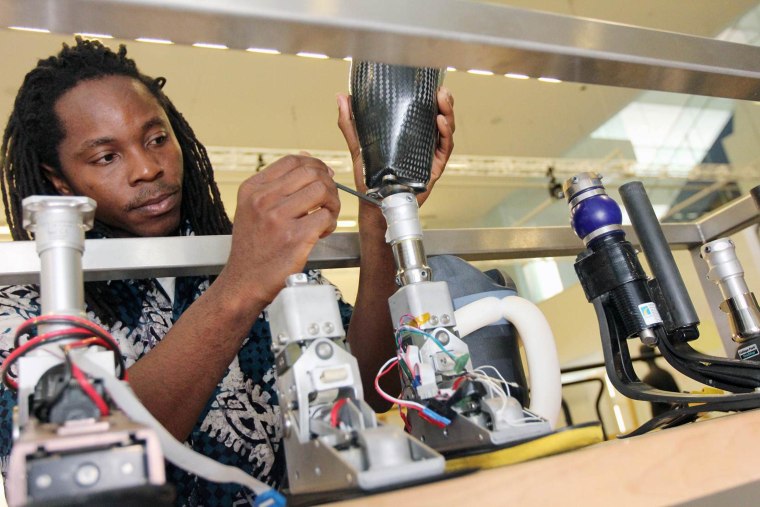A high-tech running shoe is worthless if it is two sizes too small and gives the runner blisters and pressure sores. The same goes for prosthetic limbs, according to David Sengeh, a 26-year-old graduate student from Sierra Leone who was honored Wednesday with an award for his work on an innovative socket that makes prosthetic limbs more comfortable and thus functional for amputees.
"Whether you have a robotic ankle or a wooden peg, if the socket is not functional you wouldn't use your leg," he told NBC News, explaining why he has focused his energy on developing next-generation sockets, or interfaces, for prostheses.
On Wednesday, Sengeh was selected as one of four winners of the 2014 Lemelson-MIT National Collegiate Student Prize Competition, a nationwide search for promising young innovators. He received $15,000.
Several victims of the 2013 Boston Marathon bombings along with veterans from the U.S. wars in Iraq and Afghanistan are among the patients working with Sengeh on the device at the Massachusetts Institute of Technology, he said. The graduate student aims to launch a prosthetic socket and interface design company within the next year.
Inspired to help amputees in Sierra Leone
Sengeh grew up in Sierra Leone during the African country's 11-year civil war from 1991 to 2002, where amputees were among the most common and visual reminders of the conflict. "They are present in front of you, they are alive, and you see that they struggle," he said.
Even though assistance programs provided many of the amputees with prostheses, few of the wounded wore the devices. Sengeh wanted to know why. He spent time with amputees and learned that their prostheses caused discomfort. That got him thinking. "How do you design products that people will use and that will enable them to be functional human beings again," he said.
Conventional prostheses are built from molds of patients' limbs and then fitted and modified over a series of trial-and-error visits to the doctor's office. Many patients, according to Sengeh, never get a comfortable fit. Instead they get pressure sores, deep tissue injuries, and face other challenges.
His solution uses magnetic resonance imaging along with other tools to precisely measure the shape of patients' limbs, including the location of muscles and bones. He also collects data on limb movement and other body mechanics. All of this information is incorporated into a computer model that churns out a patient-specific design. The custom interface is then built with a 3D printer.
"You remove the guesswork, you make it repeatable, you make it where you don't need a (doctor) who is not well trained to be involved," Sengeh said. The result is a snug, comfortable socket that fits from the get go and "categorically reduces the cost" compared to conventional prosthetic sockets, which in the U.S. run about $6,000, he added.
Other winners; inspiring innovators
Sengeh also runs a nonprofit, Global Minimum, to inspire young innovators to solve problems they encounter on a daily basis. For example, the organization helped 16-year-old Kelvin Doe build a battery out of acid, soda, and other metals scavenged from trash bins that he uses to light up homes in his Sierra Leone community and work on other inventions.
"You start with young people and you engage them to think creatively and to understand that they can indeed change a problem for their community," Sengeh explained.
This spirit of innovation is at the heart of the Lemelson-MIT competition, which "celebrates students who are translating research discoveries into ground breaking inventions, and fostering creative and inventive thinking among youth," Joshua Schuler, executive director of the Lemelson-MIT Program, said in a news release announcing the student prize winners.
Other prizes went to:
- $10,000 to undergraduates Alex Devon, Kayla Gainey and Tyler Ovington from Clemson University who are developing GlucoSense, a low-cost glucometer and strip system for diabetes in resource-poor settings
- $15,000 to graduate student Ben Peters from MIT who is developing a novel technique for efficiently actuating a large array of tiny pins for use as a digital modeling tool with potential for use in manufacturing, prototyping and do-it-yourself fabrication
- and $10,000 to undergraduates Mateo Penn Doll, Christopher Haid, AJ Perez and Forrest Pieper at MIT for a 3D printer designed specifically for classroom use.
